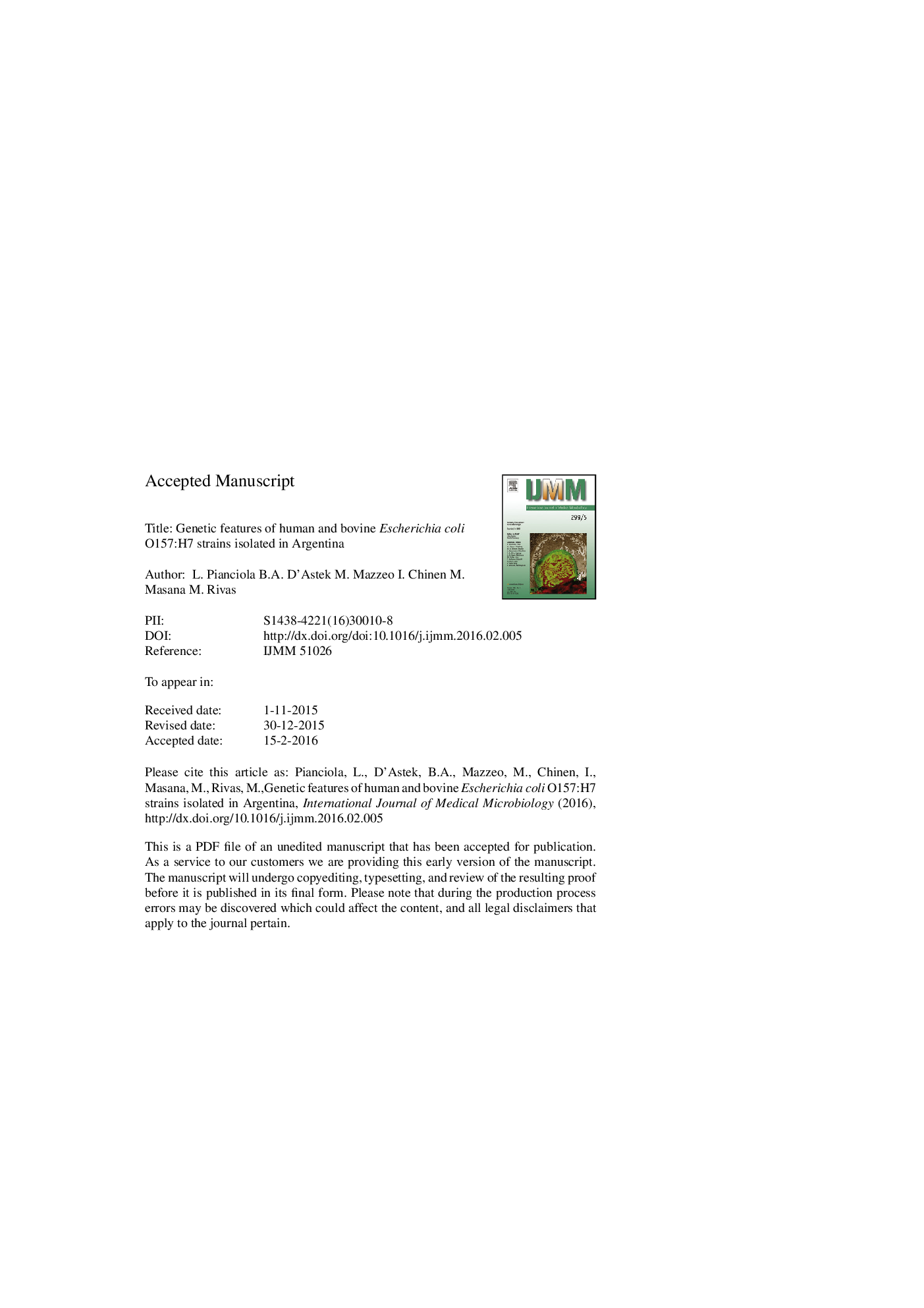| کد مقاله | کد نشریه | سال انتشار | مقاله انگلیسی | نسخه تمام متن |
|---|---|---|---|---|
| 8385138 | 1543682 | 2016 | 24 صفحه PDF | دانلود رایگان |
عنوان انگلیسی مقاله ISI
Genetic features of human and bovine Escherichia coli O157:H7 strains isolated in Argentina
دانلود مقاله + سفارش ترجمه
دانلود مقاله ISI انگلیسی
رایگان برای ایرانیان
موضوعات مرتبط
علوم زیستی و بیوفناوری
بیوشیمی، ژنتیک و زیست شناسی مولکولی
بیوشیمی، ژنتیک و زیست شناسی مولکولی (عمومی)
پیش نمایش صفحه اول مقاله

چکیده انگلیسی
Shiga toxin-producing Escherichia coli (STEC) are important food-borne pathogens associated with human diseases. In Argentina, O157:H7 is the dominant serotype in hemolytic uremic syndrome (HUS) cases. Previously, we have described the almost exclusive circulation of human E. coli O157 strains belonging to the hypervirulent clade 8 in Neuquén Province. The aim of the present study was to investigate, by a broad molecular characterization, if this particular distribution of E. coli O157 clades in Neuquén is similar to the situation in other regions of the country and if it may be originated in a similar profile in cattle, its main reservoir. Two-hundred and eighty O157 strains (54 bovine and 226 human) isolated between 2006 and 2008 in different regions of Argentina were studied. All strains harbored rfbO157, fliCH7, eae, and ehxA genes. The predominant genotype was stx2a/stx2c in human (76.1%) and bovine (55.5%) strains. All human isolates tested by Lineage-Specific Polymorphism Assay (LSPA-6), were lineage I/II; among bovine strains, 94.1% belonged to lineage I/II and 5.9% to lineage I. No LSPA-6 lineage II isolates were detected. Single nucleotide polymorphism (SNP) analysis has revealed the existence of nine clade phylogenetic groups. In our clinical strains collection, 87.6% belonged to the hypervirulent clade 8, and 12.4% were classified as clade 4/5. In bovine isolates, 59.3% strains were clade 8, 33.3% clade 4/5 and 7.4% clade 3. More than 80% of human strains showed the presence of 6 of the 7 virulence determinants described in the TW14359 O157 strain associated with the raw spinach outbreak in the U.S. in 2006. More than 80% of bovine strains showed the presence of 3 of these factors. The q933 allele, which has been related to high toxin production, was present in 98.2% of clinical strains and 75.9% of the bovine isolates. The molecular characterization of human STEC O157 strains allows us to conclude that the particular situation previously described for Neuquén Province, may actually be a characteristic of the whole country. These genetic features are quite similar to those observed in the bovine reservoir and may be derived from it. This data confirms that, unlike the rest of the world, in Argentina most of the STEC O157 strains present in cattle may cause human infections of varying severity and the marked virulence described for these strains may be related to the high incidence of HUS in our country.
ناشر
Database: Elsevier - ScienceDirect (ساینس دایرکت)
Journal: International Journal of Medical Microbiology - Volume 306, Issue 2, February 2016, Pages 123-130
Journal: International Journal of Medical Microbiology - Volume 306, Issue 2, February 2016, Pages 123-130
نویسندگان
L. Pianciola, B.A. D'Astek, M. Mazzeo, I. Chinen, M. Masana, M. Rivas,